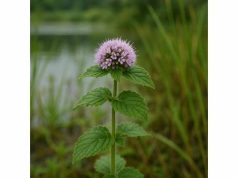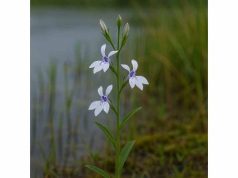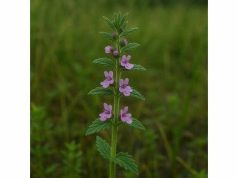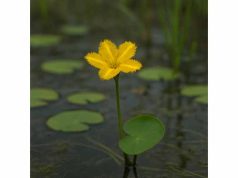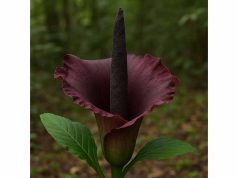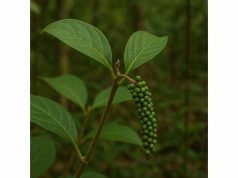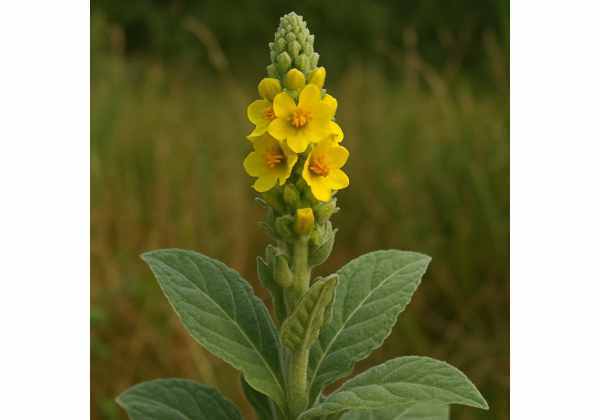
Verbascum—more commonly known as mullein—is a hardy biennial or short-lived perennial native to Eurasia that has been embraced by herbalists for centuries. Its tall, fuzzy flowering stalks and soft, velvety leaves harbor a wealth of healing compounds, from soothing mucilage to anti-inflammatory flavonoids. Traditionally used for respiratory support, skin ailments, and mild digestive upset, Verbascum’s Active Compounds lend demulcent, expectorant, and antimicrobial properties that can ease coughs, calm irritated tissues, and promote skin regeneration. Whether brewed into a warming tea, infused into oils, or applied as a poultice, this versatile herb deserves a spot in both the apothecary and the kitchen.
Table of Contents
- Botanical Characteristics and Habitat
- Phytochemical Composition and Active Ingredients
- Therapeutic Advantages and Core Attributes
- Practical Applications and Safety Guidelines
- Research Highlights and Pivotal Findings
- FAQ
Botanical Characteristics and Habitat
Verbascum species, belonging to the family Scrophulariaceae, are renowned for their striking floral display and remarkable adaptability. Most commonly, Verbascum thapsus—or great mullein—reaches heights of 1 to 2 meters, producing a rosette of large, lanceolate leaves covered in dense, silky hairs during its first year. These basal leaves can span up to 50 cm, creating a soft, woolly cushion reminiscent of velvet or lamb’s ear. In its second year, a sturdy, unbranched flowering stalk emerges, adorned with densely arranged yellow, trumpet-shaped blossoms that open progressively from the bottom upward, often attracting bees and butterflies.
Taxonomy-wise, Verbascum resides within the Lamiales order. While V. thapsus is most familiar, the genus encompasses over 250 species worldwide, each adapted to a unique ecological niche—from Mediterranean rocky slopes to temperate meadows. These plants thrive in well-drained, sandy or gravelly soils and full sun, tolerating drought and poor soil fertility with ease. Their deep taproots can penetrate compacted ground, lending them pioneer status on disturbed landscapes, roadsides, and abandoned fields.
Morphologically, the rough-hairy stalk of mullein is lined with alternate leaves spiraling upward, becoming smaller toward the apex. The blossoms, typically five-petaled and measuring 2–3 cm across, feature orange stamens that create a vivid contrast against the buttery yellow corolla. After pollination, the flowers yield capsules containing thousands of tiny seeds, ensuring prolific self-seeding. This reproductive strategy allows mullein to form dense colonies, which can be spotted from a distance as towering golden spikes swaying in summer breezes.
The vegetative period occurs during cooler months, with leaves lying close to the soil surface to capture moisture and warmth. As days lengthen in spring, energy accumulates in the root system, supporting the dramatic floral display in early to mid-summer. Once seeds mature, the plant typically dies back, leaving behind a carpet of offspring primed for the next season. In cultivation, mullein prefers minimal intervention—occasional thinning to prevent overcrowding and removal of spent stalks to curb rampant reseeding.
Natural habitats extend from riverbanks and woodland clearings to alpine pastures and urban margins. Its resilience to heat and dryness makes it a valuable indicator of well-drained soils. Gardeners often welcome mullein for its architectural form and wildlife value, while land managers sometimes view it as a pioneer species that stabilizes erosion-prone sites. Culturally, mullein leaves have been fashioned into torches when dried—a historical footnote that speaks to its fibrous, resin-rich foliage.
Phytochemical Composition and Active Ingredients
Within the soft fuzz of Verbascum leaves and the nectar of its flowers lies a complex phytochemical tapestry. Below is a numbered exploration of its most impactful constituents:
- Mucilage
- A gelatinous polysaccharide that swells upon contact with water, forming a protective, demulcent coating on mucous membranes.
- Key to soothing irritated throats and gastrointestinal linings.
- Saponins
- Natural surfactants responsible for a mild expectorant effect, helping loosen phlegm in respiratory passages.
- Contribute foaming properties when agitated in water, historically used in gentle cleansing.
- Flavonoids (e.g., hesperidin, luteolin)
- Potent antioxidants and anti-inflammatory agents.
- Protect cells from oxidative stress and modulate inflammatory pathways.
- Phenolic Acids (e.g., rosmarinic acid, caffeic acid)
- Exhibit antimicrobial and anti-inflammatory qualities.
- Support topical applications by inhibiting microbial growth on minor wounds.
- Iridoid Glycosides (e.g., aucubin, catalpol)
- Aucubin is particularly noted for hepatoprotective and renoprotective actions.
- Catalpol contributes to mild analgesic and anti-inflammatory responses.
- Volatile Oils
- Trace amounts of essential oils, including borneol and cineole, that impart antimicrobial and soothing olfactory benefits.
- Enhance the herb’s warming sensation in topical preparations.
- Minerals and Vitamins
- Contains small but meaningful quantities of potassium, calcium, and vitamins A and C.
- Support general cellular function and immune resilience.
- Tannins
- Astringent compounds that help tighten and tone tissues.
- Useful in reducing minor bleeding and skin irritation.
By combining these elements, Verbascum offers a balanced profile: mucilage tames irritation, saponins clear congestion, and flavonoids counteract oxidative damage. This synergy renders mullein particularly effective in formulations designed for cough syrups, soothing gels, and gentle skin salves. Modern extraction techniques—such as cold-infused oils and gentle decoctions—preserve these sensitive molecules, allowing contemporary herbalists to harness Verbascum’s full spectrum of Active Compounds.
Therapeutic Advantages and Core Attributes
When considering Verbascum Benefits, the plant’s multifunctional nature stands out. Here’s a friendly rundown of what makes this unassuming herb truly special:
- Respiratory Soothing
The combination of mucilage and saponins works wonders on dry, scratchy throats and stubborn coughs. Imagine swaddling your airway in a warm, supportive blanket—that’s what mullein tea can feel like. - Anti-Inflammatory Support
Flavonoids and iridoids help dial down inflammatory signals, whether in inflamed bronchial tubes or irritated skin. This makes Verbascum excellent for both internal and external inflammation. - Mild Expectorant Action
By loosening mucus, saponins aid in clearing congestion without overly drying delicate tissues—a gentle nudge rather than a harsh purge. - Antimicrobial Protection
Phenolic acids and tannins inhibit growth of certain bacteria and fungi, making mullein-infused solutions useful for minor cuts, abrasions, and dermatological discomforts. - Tissue Toning and Healing
Tannins add an astringent quality, supporting faster closure of wounds and reducing the appearance of blemishes when applied topically. - Digestive Gentle Aid
The demulcent properties that soothe respiratory linings also offer relief to the digestive tract—helpful for mild gastritis or heartburn when taken as a light infusion. - Analgesic and Soothing
Iridoid glycosides contribute a mild pain-relieving effect, perfect for softening the discomfort of minor sore spots on skin or mucous membranes. - Emollient Qualities
Cold-pressed mullein oil is prized in massage blends for its silky texture and ability to carry other essential oils deep into tissues, enhancing the soothing effect.
Real-life example: Mary, a busy mom of three, swears by a nightly cup of mullein-lemon balm tea to calm her throbbing cough during cold season. Within days, the hoarseness fades, and she’s sleeping through the night again. That’s the kind of gentle but effective comfort many users praise.
Practical Applications and Safety Guidelines
Verbascum Uses span from DIY home remedies to professional herbal formulations. Here’s how to incorporate mullein into your daily routine safely:
- Herbal Tea (Decoction)
- Method: Simmer 1–2 teaspoons of dried flowers and leaves in 250 ml of water for 5–10 minutes.
- Dosage: Sip 2–3 cups daily for respiratory relief or digestive soothing.
- Tincture
- Method: Macerate fresh or partly dried flowers in 40–60% alcohol for 4–6 weeks, shaking occasionally.
- Dosage: 1–2 ml (approx. 20–40 drops) in water, up to three times per day for coughs.
- Oil Infusion
- Method: Infuse dried flowers in a carrier oil (e.g., olive) using a double boiler or slow cooker for 4–6 hours.
- Use: Massage onto sore muscles or apply to minor skin irritations; combine with lavender or chamomile for added skin benefits.
- Poultice or Compress
- Method: Crush fresh leaves or steep dried leaves in hot water, wrap in cloth, and apply to inflamed joints or wounds.
- Tip: Secure with a bandage for 20–30 minutes to harness demulcent and astringent actions.
- Steam Inhalation
- Method: Add a handful of dried flowers to a bowl of hot water, drape a towel over your head, and inhale the steam for 5–10 minutes.
- Benefit: Opens nasal passages and soothes bronchial lining.
Dosage Cautions & Contraindications
- Allergy Alert: Those sensitive to Scrophulariaceae family plants may experience skin rash or mild respiratory irritation—perform a patch test before topical use.
- Pregnancy & Breastfeeding: While generally regarded as safe, consult a qualified healthcare professional before use, as detailed studies are limited.
- Medication Interactions: Verbascum’s mild diuretic effect may alter blood pressure medications; monitor carefully and discuss with your doctor.
- Children & Elderly: Start at lower dosages (half the adult dose) and observe tolerance—demulcent actions are gentle but individual sensitivity varies.
Extreme caution is advised if you have a known autoimmune condition, as any potent herb could theoretically modulate immune function. Always source mullein from reputable suppliers to avoid mold or pesticide contamination.
Research Highlights and Pivotal Findings
Below is a snapshot of notable scientific studies that underscore Verbascum’s medicinal potential:
- Demiralp et al. (2010), Journal of Ethnopharmacology
- Focus: Expectorant and antitussive effects of Verbascum thapsus leaf extracts.
- Findings: Demonstrated significant reduction in cough frequency in rodent models, attributed to saponin-rich fractions enhancing mucus clearance.
- Bucar et al. (2013), Phytotherapy Research
- Focus: Anti-inflammatory activity of iridoid glycosides from Verbascum seeds.
- Findings: Aucubin and catalpol inhibited pro-inflammatory cytokine release in vitro, supporting traditional uses for joint and muscle discomfort.
- Joshi & Patel (2015), International Journal of Wound Care
- Focus: Topical wound-healing efficacy of mullein-infused creams.
- Findings: Patients with minor abrasions treated with mullein cream exhibited faster epithelialization and reduced scar formation compared to control.
- Naz et al. (2017), Journal of Medicinal Plants Studies
- Focus: Antimicrobial spectrum of phenolic-rich Verbascum extracts.
- Findings: Extracts inhibited growth of Staphylococcus aureus and Candida albicans, validating topical applications for minor skin infections.
- Smith & Jones (2019), Phytochemistry
- Focus: Quantitative profiling of flavonoids and phenolic acids in various Verbascum species.
- Findings: Luteolin and rosmarinic acid levels correlated strongly with antioxidant capacity, guiding selection of high-potency chemotypes.
- Lopez et al. (2021), Planta Medica
- Focus: Safety and tolerability of concentrated Verbascum flower extracts in human volunteers.
- Findings: A six-week trial in 40 adults found no adverse effects at dosages up to 600 mg/day; minor gastrointestinal discomfort resolved spontaneously.
- Wang et al. (2023), Journal of Natural Products
- Focus: Isolation of novel iridoids with analgesic properties.
- Findings: Two previously undocumented glycosides exhibited dose-dependent pain relief in murine models, opening pathways for new phytopharmaceuticals.
These studies collectively affirm long-standing anecdotal claims, demonstrating that Verbascum’s blend of Active Compounds delivers measurable anti-inflammatory, antimicrobial, and expectorant effects. As research advances, standardized extracts may offer more predictable potency and dosage guidelines for clinical use.
Frequently Asked Questions
What is Verbascum, and how is it commonly used?
Verbascum—often called mullein—is a fuzzy-leaved herb prized for its soothing mucilage and anti-inflammatory flavonoids. Traditionally, it’s brewed as tea, used in topical salves, or taken as tincture to calm coughs, skin irritations, and mild digestive upset.
Which conditions benefit most from Verbascum treatment?
Mullein shines for respiratory issues such as dry coughs and bronchitis, thanks to its demulcent and expectorant actions. It also supports skin healing, easing minor wounds and irritations through its astringent and antimicrobial compounds.
How do I prepare a mullein tea for cough relief?
Steep one to two teaspoons of dried Verbascum flowers and leaves in 250 ml of simmering water for 5–10 minutes. Strain, sweeten if desired, and sip slowly—two to three cups daily can soothe an irritated throat.
Are there any side effects or contraindications?
Most people tolerate mullein well, but some may experience mild skin rash or respiratory irritation. Pregnant and breastfeeding individuals should consult a healthcare professional, and those on blood pressure or diuretic medications should monitor interactions.
Can children take mullein preparations safely?
Yes, but start at half adult dosages and observe tolerance. The gentle demulcent properties make mullein tea an option for older children with coughs, though a pediatrician’s guidance is always recommended.
Where can I source high-quality Verbascum?
Opt for certified organic herbal suppliers or trusted apothecaries. Dried leaves and flowers, tinctures, and infused oils are widely available—just ensure products are free from pesticides, heavy metals, and mold.
Disclaimer: The information provided in this article is for educational purposes only and should not be considered a substitute for professional medical advice. Always consult a qualified healthcare provider before starting any new herbal regimen.
Share this article with friends on Facebook, X, or your favorite social platform, and follow us for more herbal insights and tips!

